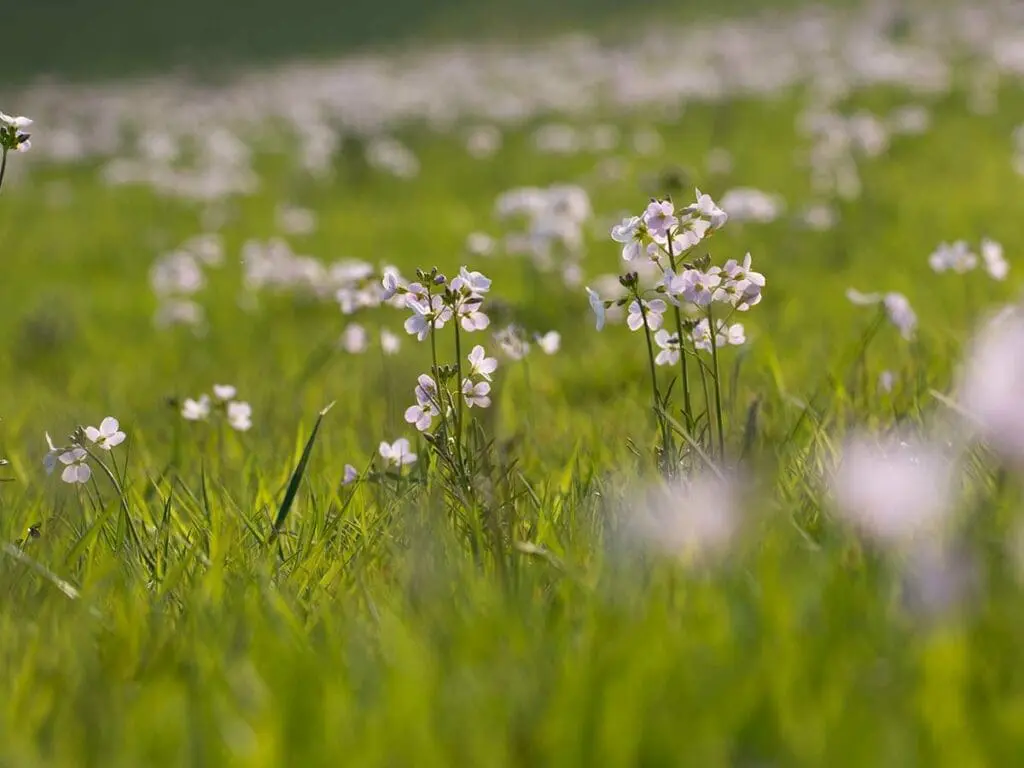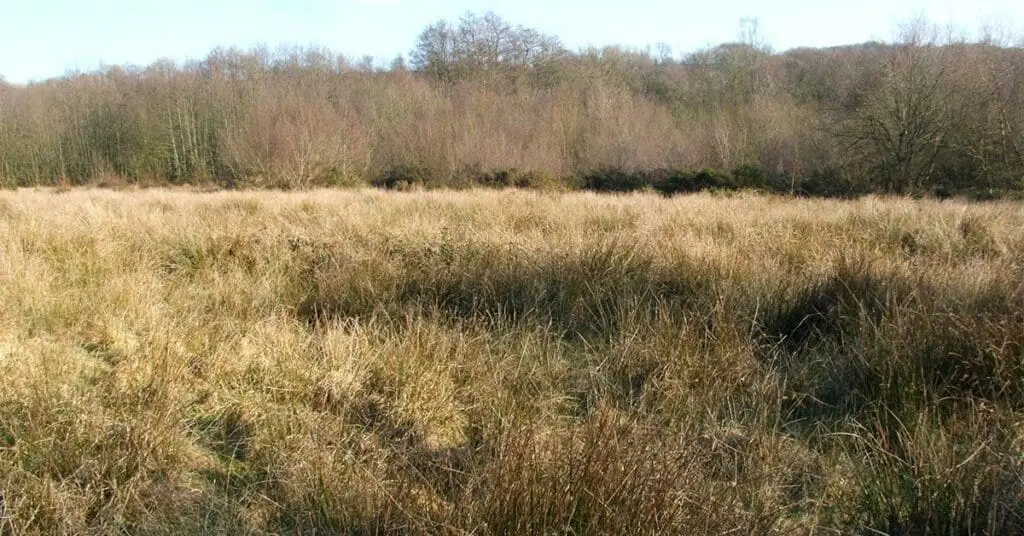Most of our wildflower meadows have been lost since 1950, mainly due to changes in farming practice. With a little bit of space, time and patience you can create a wildflower meadow in your own garden.
Imagine the peaceful sound of buzzing bumblebees. The pleasure of little butterflies, scurrying from one colourful wildflower to another. The delight of soft grass under your feet. Doesn’t it sound idyllic?
Recreating habitat
Apart from all the joy a wildflower meadow will bring you, the greatest benefit is to local wildlife. By opening your garden to many insect species like butterflies, bees or grasshoppers, you will be providing valuable habitat and helping your local biodiversity.
In turn, insects and wildflower seeds will attract birds and small mammals such as blue tits, sparrows, swallows, shrews and hedgehogs. Compared to your run-of-the-mill short-mown lawn, this is much more desirable. The two can go side by side. You don’t need to sacrifice space for the kids to kick a ball about.
Ground preparation
If you are starting with bare ground or wish to replace an existing lawn or other existing vegetation, the first step is to achieve a weed-free soil. You should try to get rid of any existing grasses or weeds (like docks or nettles). You could spray the area with a weedkiller (at least twice, with a break of 2-3 weeks in between) or you will have to weed it constantly for a certain time until all vegetation is gone. Organic weed control is best.
The ideal soil for a meadow should be quite poor. Coarse grasses will become dominant and crowd your lovely wildflowers out on richer soils. Don’t be tempted to add any fertiliser to the soil!
Before you start to sow your new meadow, the soil should be levelled. To avoid subsequent problems when cutting, a reasonably flat surface is necessary. You can achieve this by digging and raking. Clearing the site of stones and fragments of roots gives your new grass and plants a better chance to grow well. Rake to a fine tilth.
Choosing grasses and wildflowers
By this time you should have reached a weed-free, bare soil. Order a fine grass seed mixture – fescues and bents or luxury lawn mix. Make sure that the mixture does not contain perennial ryegrass, because it will quickly dominate other vegetation and doesn’t provide enough food for many insects to survive, thus offering poor wildlife value.
Try to obtain local, native wildflower seed that has been collected locally. There are a number of suppliers across the UK and Ireland.
Depending on which time of the year you would like to have colour in your meadow, take note of the different flowering times of the different wildflowers. Cuckooflower, Cowslip and Primrose flower in spring and allow the meadow to be used as a lawn during the summer.
To create a summer-flowering meadow, plant Knapweed, Ox-Eye Daisy, Bird’s-foot-trefoil, Yarrow, Lady’s bedstraw, Harebell, Meadow buttercup or Yellow rattle. Long season wildflowers such as Ribwort plantain and Self-Heal flower over a longer period of time.
All of these pretty wildflowers are perennials, which means they will come back for many growing seasons (if conditions allow). Don’t be disappointed if they don’t flower in the first year. In the early days of a meadow, perennial wildflowers establish their root system and foliage.
Annual wildflowers such as cornflowers and poppies are beautiful, but you should be aware of the fact that they won’t establish in your meadow. The management of ‘cornfield annuals’ requires a different regime, because you have to resow them every year.
You can sow some wildflowers in plugs and plant out into any gaps. The stronger the wildflowers are before you place them in your new meadow, the better they will be able to withstand competition for light, moisture and space from more aggressive grasses.
Keep it native
Try to keep your meadow native to support your local wildlife! Native plants are likely to be successful and have a higher wildlife value than so-called ‘exotics’. Some species of native wildflower can support several hundred different insect species along with those animals that feed on the insects: normally more than any non-native species can support.
There are even some insects that require one particular food plant for its larvae, always native, and which will not survive without it. If you buy seeds or plugs from a nursery, make sure that they are nursery grown stock from local seed. Never try and transplant wildflowers from the wild, it doesn’t have a good success rate and may even be against the law.
The good bit – actually create a wildflower meadow!
The best time to sow your seed mix is either early autumn (late August/early September) or spring (April/early May). If you want to sow grass and wildflowers at the same time, mix 1.5g of pure wildflower and 3.5g of grass seed per square metre. Mix with dry sand and broadcast by hand. The sand helps see where you’ve sown the seed already! Continually mix the seed and sand so that small seeds don’t settle to the bottom and you sow them all in one place.
After sowing, firm the ground to ensure good contact with the soil. Keeping the soil moist helps the seeds to germinate. If the period after sowing is dry, we recommend watering lightly. You should be able to see the first results a week or two after sowing; green blades of grass will shoot out of your seedbed. Wildflower seeds may take up to 8 weeks or longer (some may need to overwinter first) to germinate.
When sowing the grass first (3-4g per square metre) and planting wildflowers raised in plugs (about 10 per square metre) or pots (3-5 per square metre) afterwards, you increase the chance of wildflower success. Several plugs of each species should be planted close together to facilitate pollination in the first year or two until the plants get established (and it looks more natural). If you sow the grass in autumn, plant wildflower pots or plugs the following spring. If you start in spring, wait until autumn. Rake the grass and use a spade or trowel to dig little holes for the wildflowers.
Managing your meadow – the cutting regime
Wildflowers need a low nutrient level to thrive with grasses. Your wildflowers could disappear and be replaced by grasses and perennial weeds if the soil is too rich.
Negative indicators like nettles, docks and thistles show that the nutrient level is too high. The easiest way to keep your soil ‘wildflower-friendly’ is to remove the clippings when you cut your grass. The meadow should be cut to about 5cm (do not cut any lower as you may damage the roots or basal leaves of the flowers).
Cut at least three times in the first year to support root development. From then on, once a year should be enough if the grass is not too vigorous. The usual cutting time for a spring-flowering meadow is late-June until October. A summer meadow should be left uncut until mid-July. Don’t leave it too late, even though something may still be in flower. If you continually cut late, you will lose species diversity as the grasses take over!
The cuttings should be left for a few days to allow any remaining seeds to fall, and then removed to keep the fertility of the soil low. Raking helps to break up the surface and creates gaps in which new seedlings can establish themselves.
Once you create a wildflower meadow, you’re committed to a long-term project. It may take a few years to establish, although they will generally look great very quickly. With good preparation and careful management, your patience and effort will be rewarded with an oasis of birds, butterflies and bees (and much more)!



